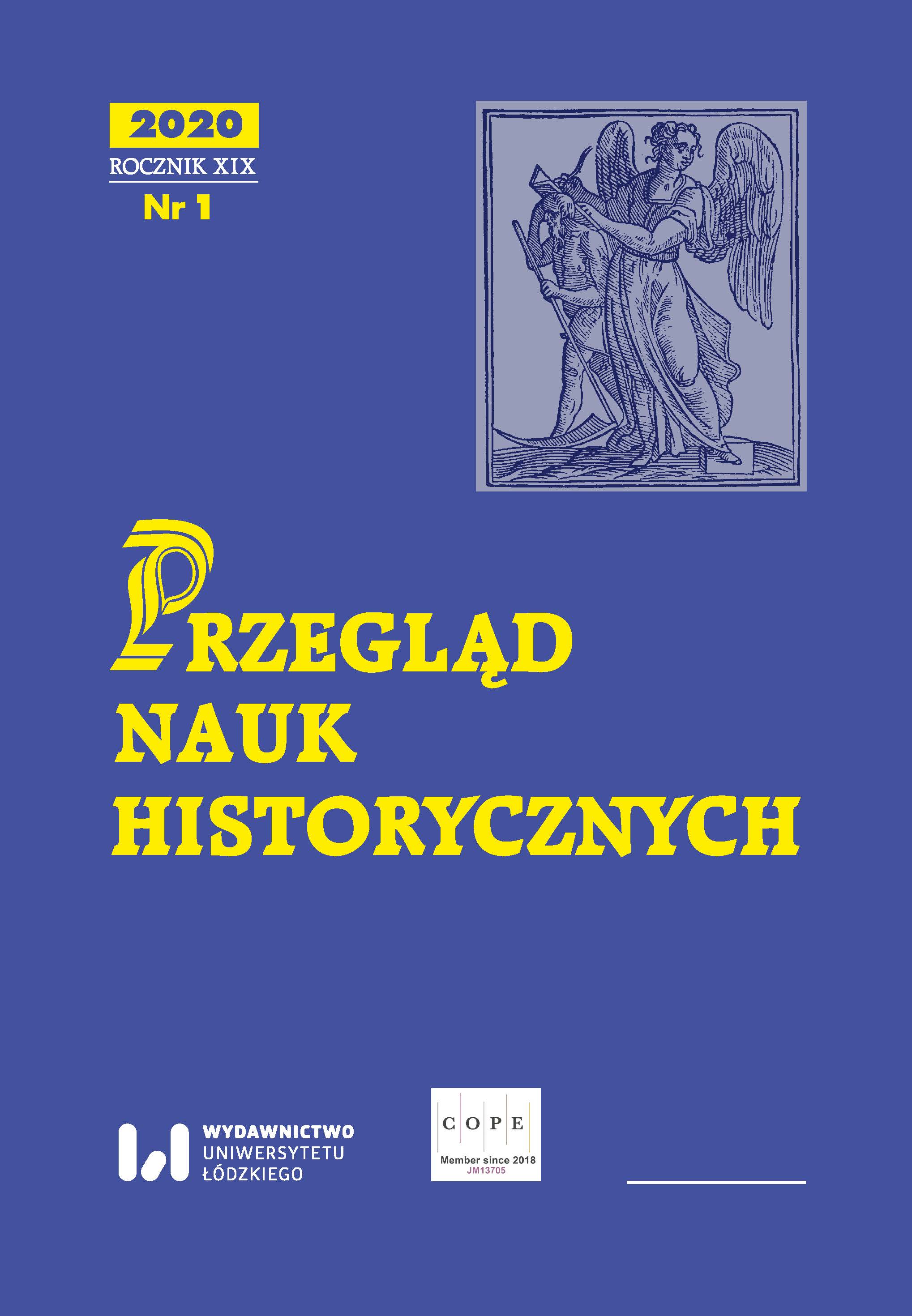The account of Slavic Rani in the medieval chronicles of Helmold and Saxo Grammaticus
DOI:
https://doi.org/10.18778/1644-857X.19.01.08Keywords:
Slavs, Rugen, medieval chronicles, paganism, ChristianizationAbstract
The Rani, a west Slavic tribe based on the island of Rugen, built an empire existing until 12th century. In 1168 Rani were defeated by Danish king Valdemar I, resulting in the conversion of the tribe to Christianity. The Chronica Slavorum by Helmoldus and Gesta Danorum by Saxo Grammaticus are quite commonly quoted sources in the debate concerning Slavic paganism and the attempts of its Christianization. What constitutes high-value Helmoldus’ and Saxo’s works is the fact that the chronicles are an essential and primary sources when it comes to the history of the Polabian tribes – their territories and their neighboring peoples. It is also a vital link in the account of the course of Christianization on the Polabian territory. After the invasion of The Danish king Valdemar I the pagan temple, situated on the island, was destroyed and both the territorial and religious autonomy of the Rani ended. At the tip of Arkona in recent centuries, the cliffs have collapsed into the sea and the chronicles still remain as witnesses of the Slavic history of Rugen.
Downloads
References
Annales Essenbecenses, ed. Societas Aperiendis Fontibus Rerum Germanicarum Medii Aevi, Hannover 1892, Monumenta Germaniae Historica, Scriptores, t. XXIX, s. 221–228.
Google Scholar
Annales Lundenses, ed. Societas Aperiendis Fontibus Rerum Germanicarum Medii Aevi, Hannover 1892, Monumenta Germaniae Historica, Scriptores, t. XXIX, s. 185–209.
Google Scholar
Ex Annalibus Islandicis, ed. Societas Aperiendis Fontibus Rerum Germanicarum Medii Aevi, Hannover 1892, Monumenta Germaniae Historica, Scriptores, t. XXIX, s. 252–266.
Google Scholar
Ex Annalibus Waldemarianis et Vitescolensibus, ed. Societas Aperiendis Fontibus Rerum Germanicarum Medii Aevi, Hannover 1892, Monumenta Germaniae Historica, Scriptores, t. XXIX, s. 176–181.
Google Scholar
Ex Chronica Danorum Sialandica, ed. Societas Aperiendis Fontibus Rerum Germanicarum Medii Aevi, Hannover 1892, Monumenta Germaniae Historica, Scriptores, t. XXIX, s. 210–216.
Google Scholar
Ex Historia Danorum dicta Knytlingasaga, ed. Societas Aperiendis Fontibus Rerum Germanicarum Medii Aevi, Hannover 1892, Monumenta Germaniae Historica, Scriptores, t. XXIX, s. 271–322.
Google Scholar
Ex Saxonis Gestis Danorum, ed. Societas Aperiendis Fontibus Rerum Germanicarum Medii Aevi, Hannover 1892, Monumenta Germaniae Historica, Scriptores, t. XXIX, s. 43–161.
Google Scholar
Helmolda Kronika Słowian, przeł. J. Matuszewski, Warszawa 1974.
Google Scholar
Helmoldi Presbyteri Bozoviensis Cronica Slavorum, ed. B. Schmeidler, Hannover 1937, Scriptores Rerum Germanicarum in usum scholarum.
Google Scholar
Saxo Grammaticus, Gesta Danorum kronika Danii, przeł. J. Wołucki, Sandomierz 2014, Biblioteka Tradycji Europejskiej, nr 52.
Google Scholar
Banach S., Saxon, Slavs and conversion: Toward a New Understanding of Crusade, „Clio’s Scroll” [Berkeley] 2016, vol. XVII, No. 1, s. 27–36.
Google Scholar
Banaszkiewicz J., Czym była i jak została zniszczona chorągiew Świętowita (Saxo Grammaticus, Gesta Danorum, XIV, 39, 14–28), [w:] W stronę rytuałów i Galla Anonima, Kraków 2018, s. 133–153.
Google Scholar
Barkowski R.F., Połabie 983, Warszawa 2015, seria: Historyczne Bitwy.
Google Scholar
Galas I., Od religio do superstitio wśród Słowian Połabskich według kronikarza Helmolda, [w:] Odkrywanie Europy Środkowej – od mitologii do rzeczywistości, red. M. Danielewski, R.R. Tomczak, Poznań 2016, Publikacje Instytutu Historii 143, s. 25–32.
Google Scholar
Gieysztor A., Mitologia Słowian, Warszawa 2006, seria: Communicare.
Google Scholar
DOI: https://doi.org/10.31338/uw.9788323525486
Kajkowski K., Kuczkowski A., Religia Pomorzan we wczesnym średniowieczu, Pruszcz Gdański 2010, Etnografia dla każdego, nr 2.
Google Scholar
Łowmiański H., Religia Słowian i jej upadek, Warszawa 1986.
Google Scholar
Milewski T., Pierwotne nazwy wyspy Rugii i słowiańskich jej mieszkańców, „Slavia Occidentalis” 1930, t. IX, s. 292–306.
Google Scholar
Modzelewski K., Barbarzyńska Europa, Warszawa 2004.
Google Scholar
Myśliński K., Bogusław I książę Pomorza Zachodniego, Bydgoszcz–Gdańsk–Szczecin 1948.
Google Scholar
Rosik S., Interpretacja chrześcijańska religii pogańskich Słowian w świetle kronik niemieckich XI–XII wieku (Thietmar, Adam z Bremy, Helmold), Wrocław 2000, Historia CXLIV.
Google Scholar
Słownik starożytności słowiańskich, red. G. Labuda Z. Stieber, t. IV, Wrocław–Warszawa–Kraków 1970.
Google Scholar
Słownik starożytności słowiańskich, red. G. Labuda Z. Stieber, t. VII, Wrocław–Warszawa–Kraków 1982.
Google Scholar
Soszyński J., Święty Wit a Świętowit Rugijski. Z dziejów legendy, „Przegląd Humanistyczny” 1984, t. XXVIII, nr 9/10, s. 133–139.
Google Scholar
Strzelczyk J., Słowianie Połabscy, Poznań 2013.
Google Scholar
Vlasto A.P., The entry of the Slavs Into Christendom. An Introduction to the Medieval History of the Slavs, Cambridge 1970.
Google Scholar
DOI: https://doi.org/10.1017/CBO9780511583759
http://naukawpolsce.pap.pl/aktualnosci/news%2C405803%2Cna-rugii-odkryto-budowle-kultowa-z-czasow-slowian.html (dostęp: 18 VII 2015).
Google Scholar
www.dmgh.de/de/fs1/object/display.html?sortIndex=010:070 (dostęp: 25 V 2018).
Google Scholar
www.ocf.berkeley.edu/…/Saxon-and-Slavs-and-Conversion (dostęp: 1 II 2018).
Google Scholar
Downloads
Published
How to Cite
Issue
Section
License

This work is licensed under a Creative Commons Attribution-NonCommercial-NoDerivatives 4.0 International License.













